We surveyed 500 web designers to find out more about what it means to be a web designer in today’s climate. The survey questioned them on their experiences working in the industry, including finding work, getting paid, client attitudes, personal development and more.
We received detailed replies to 33 questions. So these results represent the most up-to-date snapshot of the web design industry.
Some key findings include:
- 50% of web designers work alone as sole traders
- Web designers are typically paid less than the national salary average for full-time workers
- Nearly half of web designers don’t feel confident when pitching their fees
- Only 12% of web designers feel they consistently charge enough for their services
- 87% of web designers agree that clients often underestimate the cost of web design
- 80% believe technical SEO is a key skill for a web designer to have
- Over two thirds of web designers agree or strongly agree that WordPress is their preferred platform
- 87% of web designers use word of mouth to gain new clients but only 51% have their own website for lead generation
- 43% of web designers are producing industry content through blogs, podcasts, newsletters etc
- 70% of web designers are as excited about being a web designer as they were a year ago
About this survey
After recent events, when working life was completely turned on its head, each and every industry is taking a step back to consider…where are we now?
And the web design world is no different. From career prospects to client expectations, tech professionals across the board are wondering how has the sector changed? What challenges lay ahead? What opportunities?
To answer these questions and shed light on the marketplace, 20i’s Web Design Survey canvassed 500 designers on their businesses, work preferences and more.
In this report, we have distilled those insights to give you a state of the field overview, to understand how things stand now and what the future may hold.
Let’s dive in…
Section 1: About you
First up, we wanted to find out about the respondents’ web design career and the type of tasks they’re involved in.
The idea was to understand what it looks like to operate in this industry. If the traditional office 9-5 still reigns supreme, how many colleagues they work alongside? Do they share their expertise by creating original content?
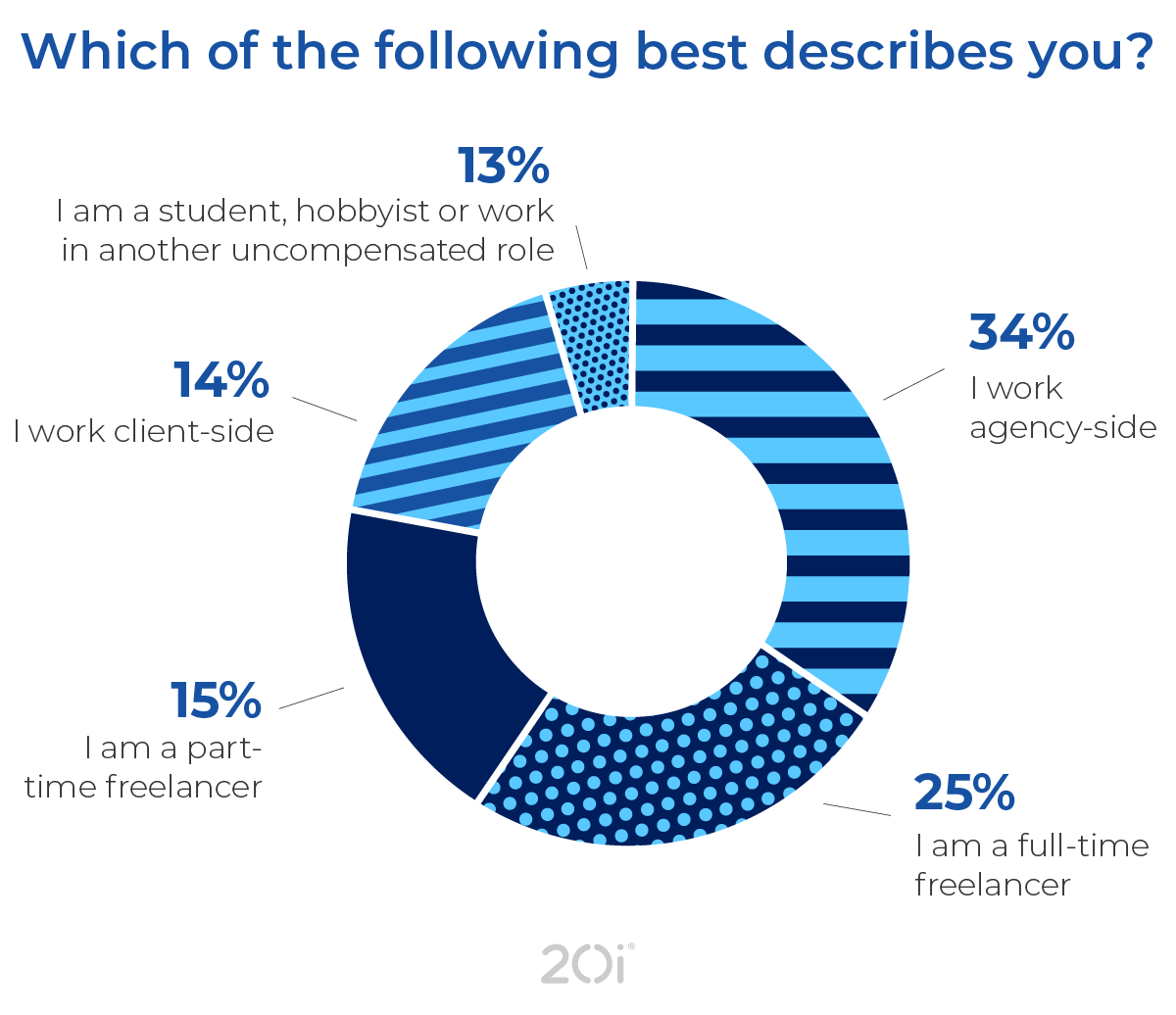
The majority of respondents were employed in a non-freelance capacity, i.e. a permanent role. Of these, twice as many worked for an agency – rather than client-side. This represents the greater proliferation of agency-side web design positions.
Taking the pandemic into account, however, the ratio could also speak to how the growing appetite for digital services is benefitting agencies. This is while other sectors (comprised of client-side organisations) have faced financial challenges and thus implemented staff cutbacks.
Another key stat here is that 44% of respondents are freelancing. This suggests that a significant number of professionals are opting out of traditional salaried positions and taking matters into their own hands.
This could point to ongoing uncertainties around job security in the present climate. This is supported by the fact that almost a fifth of respondents are freelancing part-time alongside a permanent role, whether to ‘hedge one’s bets’ or supplement income.
Web designer stats: business size
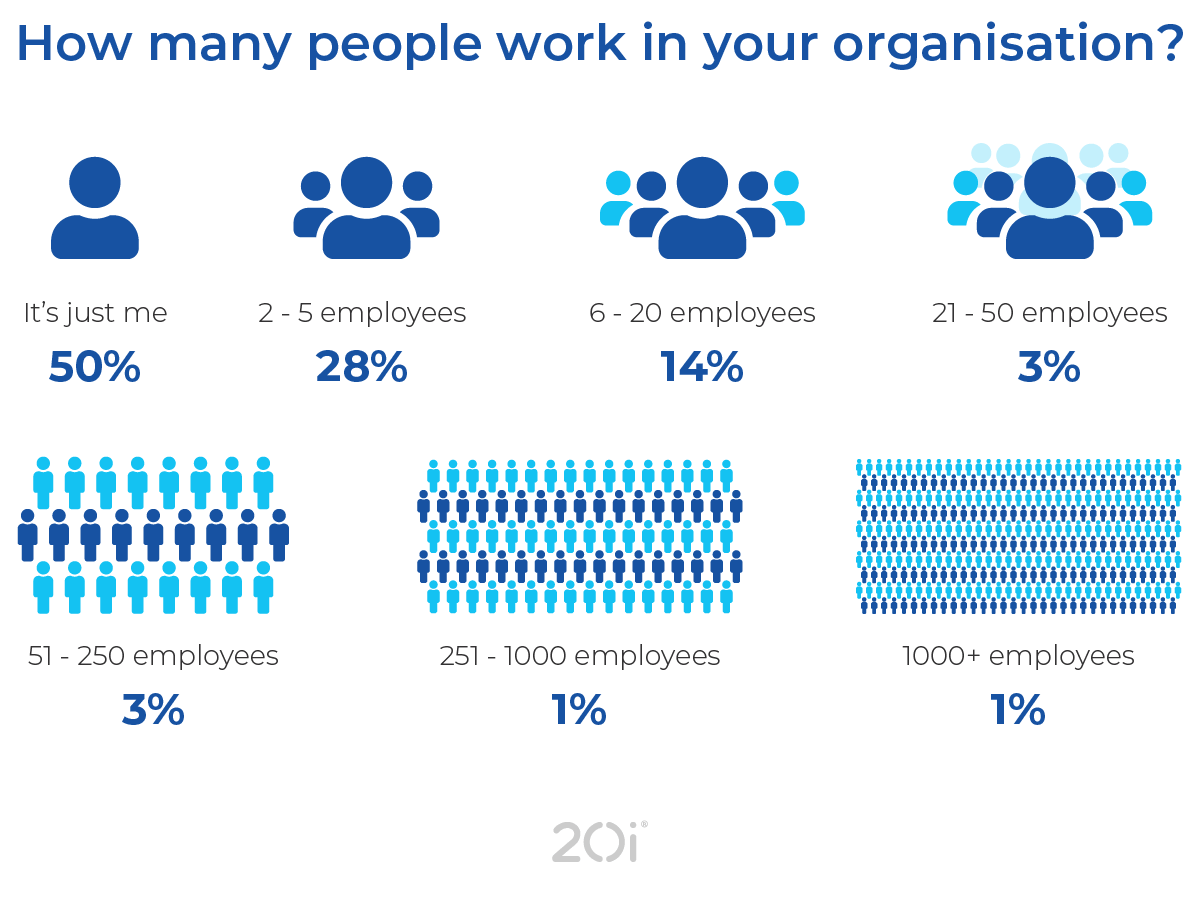
Lone wolves, mavericks, Han Solos…whatever you call it, most web designers work alone , either freelance or as part of a wider organisation. And of those who do operate alongside others, only 8% do so in businesses with more than 20 employees.
With so many functioning as solo operators or in very small teams, it’s clear that this continues to be a popular career. Web design spawns large numbers of start ups and enterprises dedicated to creative and/or digital work.
This explains some of the difficulties facing web designers when it comes to pitching accurate prices…but more of that to come later.
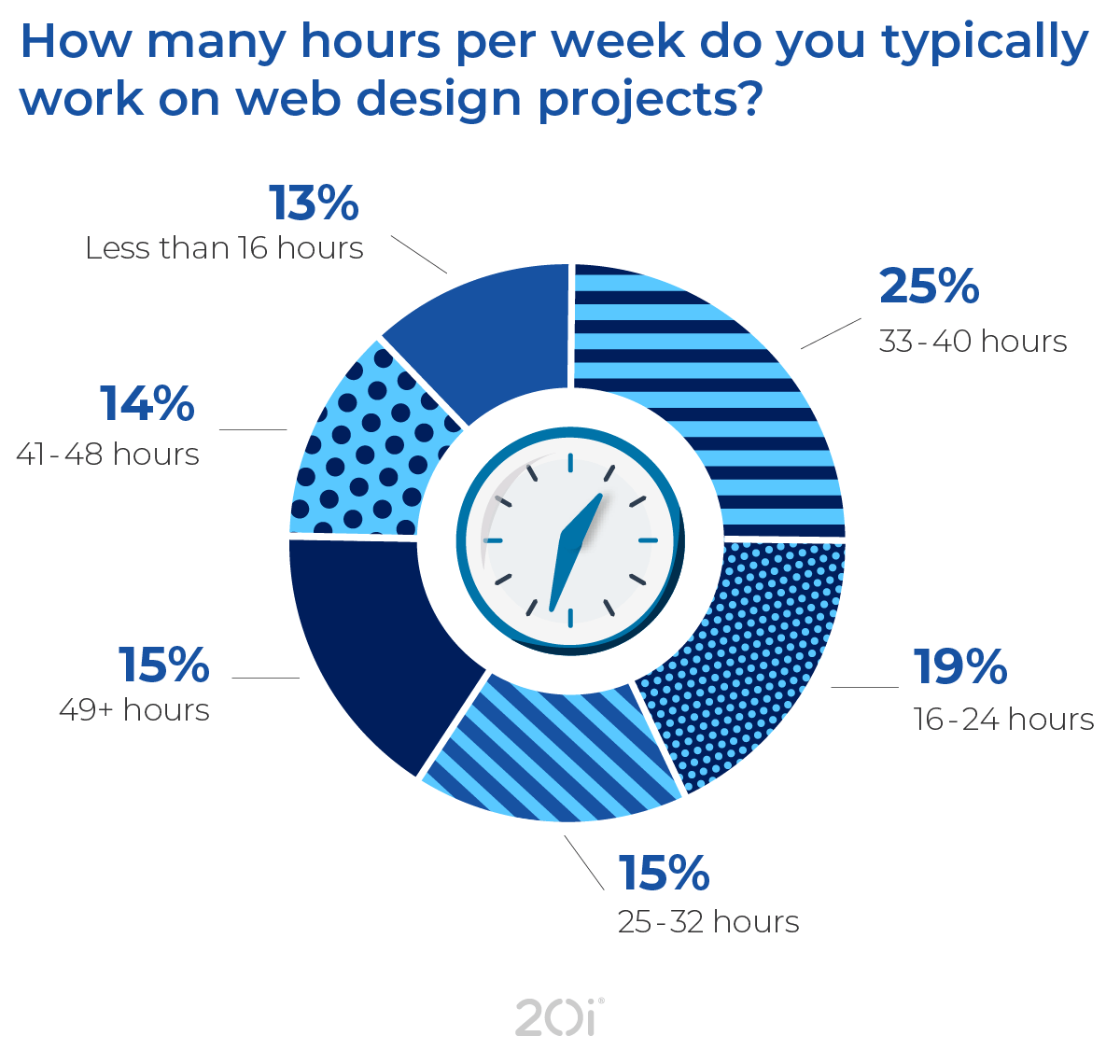
This is even more apparent when we note that these hours do not include other outputs such as admin tasks. This demonstrates how sought-after is the field’s skillset.
Web design stats: creating your own content
Here we asked if respondents used any platforms to create original content and share their ideas.
Interestingly, a huge 43% of web designers are producing web design-focused content , with the top publishing platforms being:
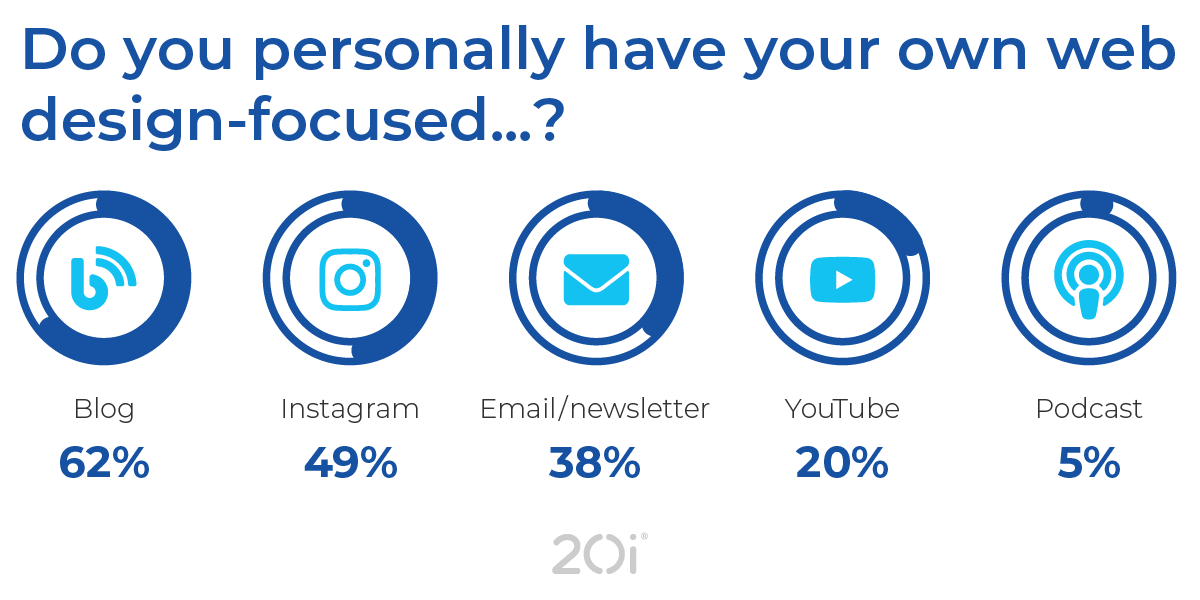
This shows that professional self-promotion is now a priority for the sector, whether for networking or business development purposes.
Blogging is by far the favoured platform. This is possibly thanks to its associated SEO benefits, or its usefulness for displaying a range of expertise.
Section 2: Getting paid
In this section we asked respondents about how much they are earning and how hard they are having to work for it.
The answers will help benchmark the industry and build a picture of the commercial opportunities and obstacles facing web designers.
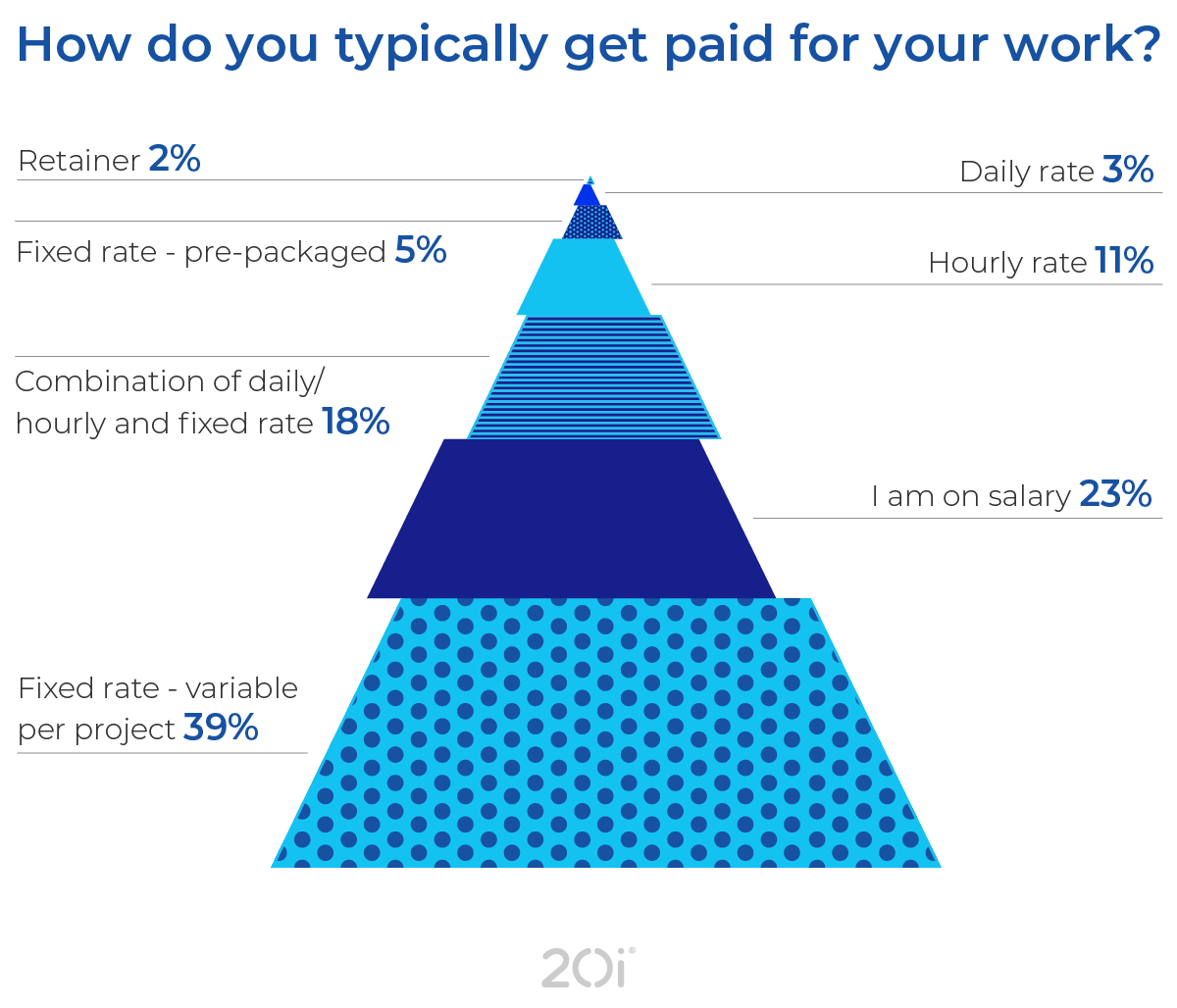
Of the non-salaried web designers, the most common pricing models are fixed rate per project and a combination of fixed rate + daily/hourly rate to cover any additional tasks.

This is a tale of two extremes.
On one hand, almost a third do not ask for a deposit, but of those who do, 40% ask for over 30% payment up front .
This stat reveals that many aren’t asking for a deposit. It could suggest market confidence, with web designers sure that clients need their work enough to pay for it in full.
Conversely, the prevalence of hefty deposits may also imply a sense of insecurity, in which organisations are exercising caution to safeguard cashflow.
Salaries for web designers
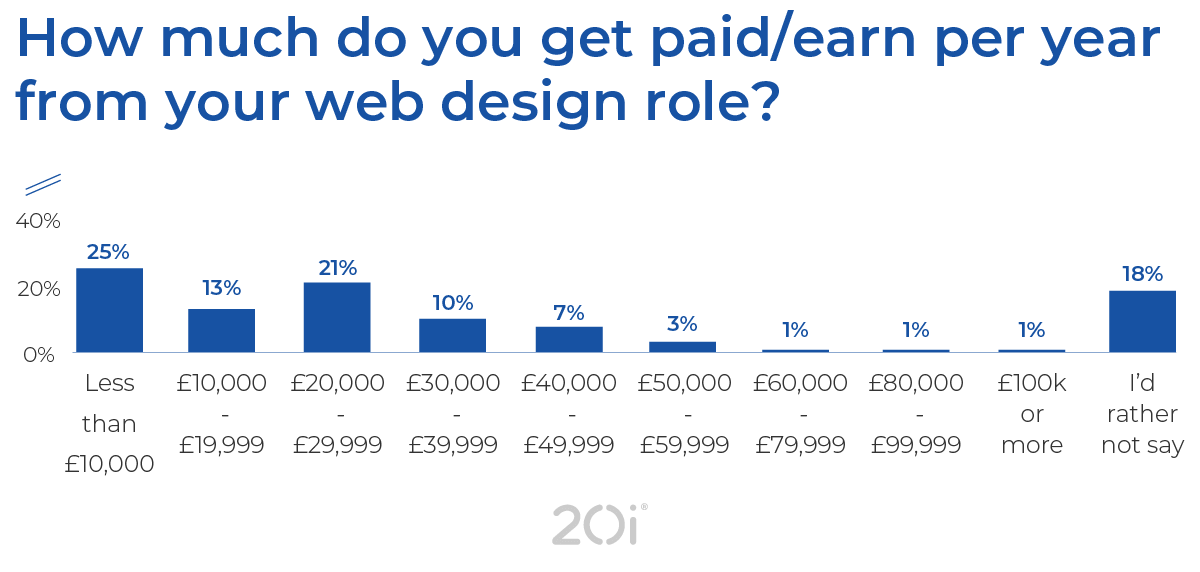
Taking the average number of hours spent on web design projects (35 hours) and our respondents’ average annual income (£23,000/$32,350), we get a rate of £12.64/$17.40 per hour .
If we then compare full-time workers across client-side, agency-side and freelance, we can see that web designers tend to make higher wages through agency employment. This may be due to a combination of more hours and better hourly rates:
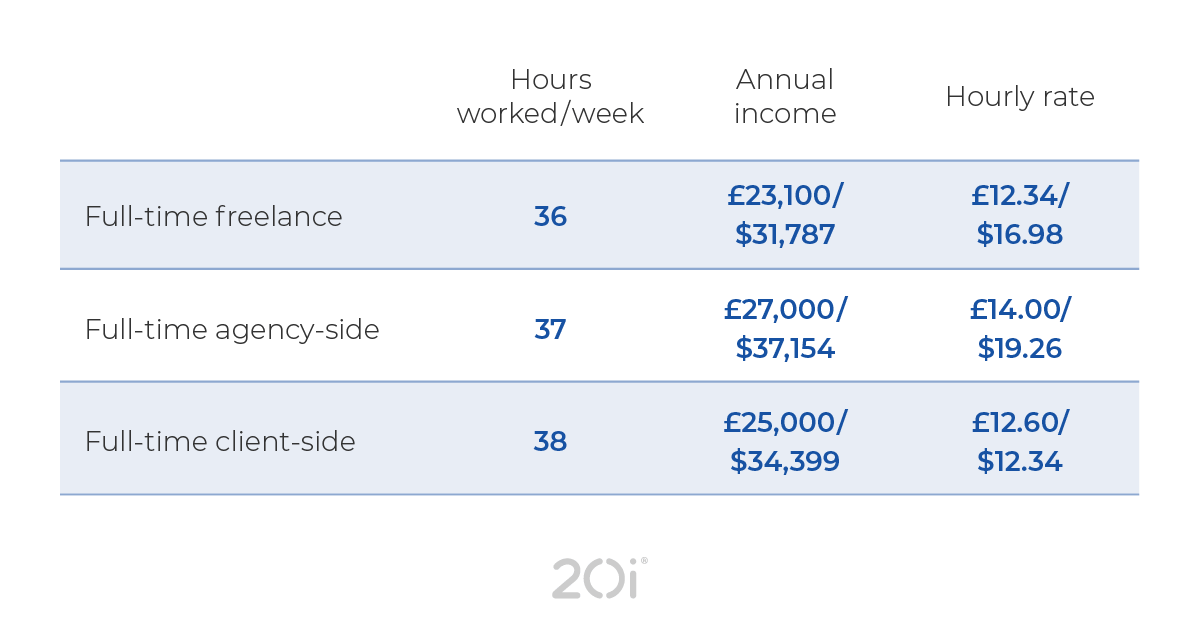
As an industry, these stats place web design behind many other professional services. In terms of annual earnings, the sector falls below the £29,600 -£31,400 UK average annual salary for full-time workers , and the income commanded by other creative and tech spheres, such as graphic design at £28,900 and web development at £34,000.
This shortfall indicates a particularly competitive and saturated marketplace. Perhaps also, it’s an industry leaning toward inaccurate pricing, or insufficient assurance to pitch at true value…more on this later.
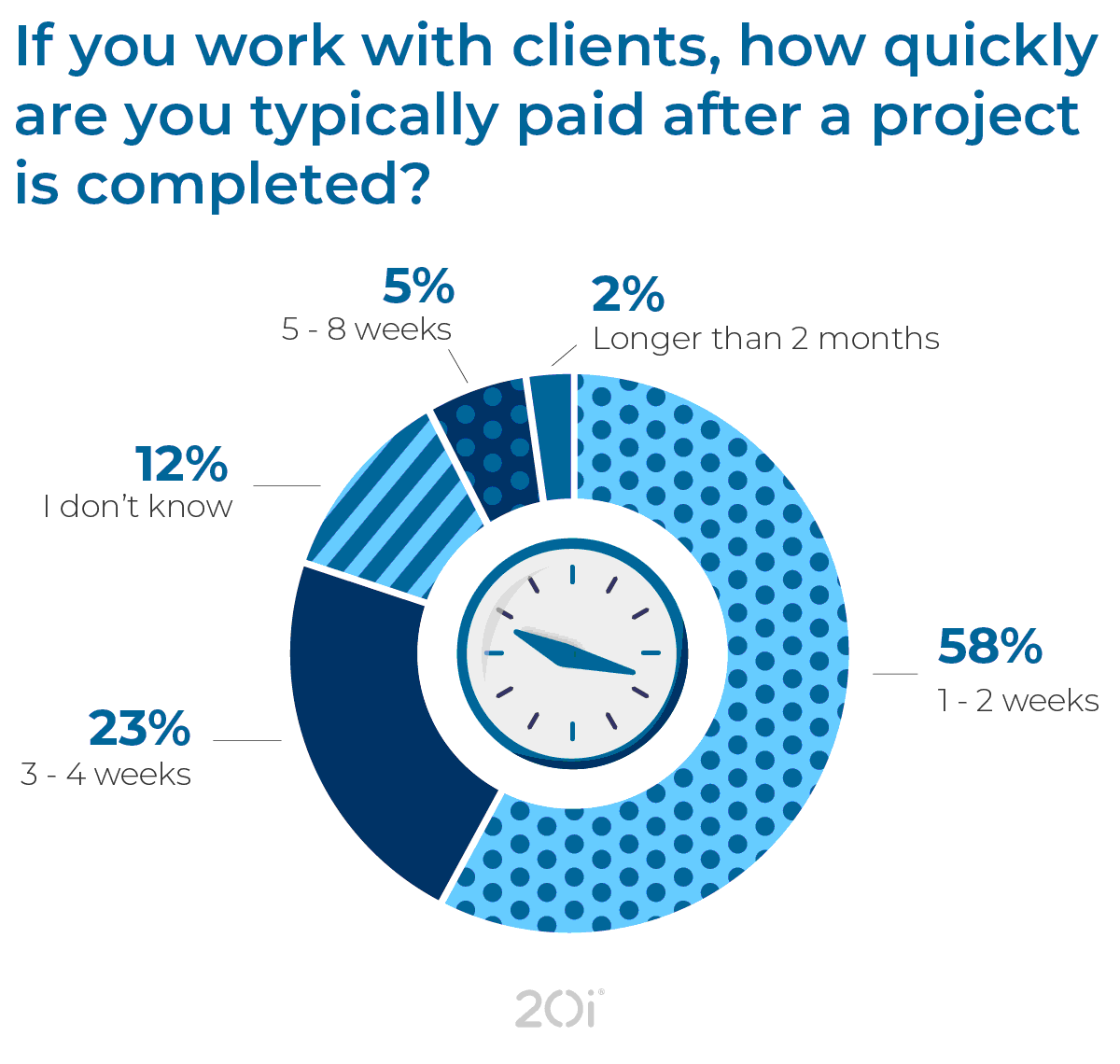
The good news is that most of you aren’t having to chase clients for payment very often, with over 81% getting paid within a month of completing the job .
Setting prices for web design work
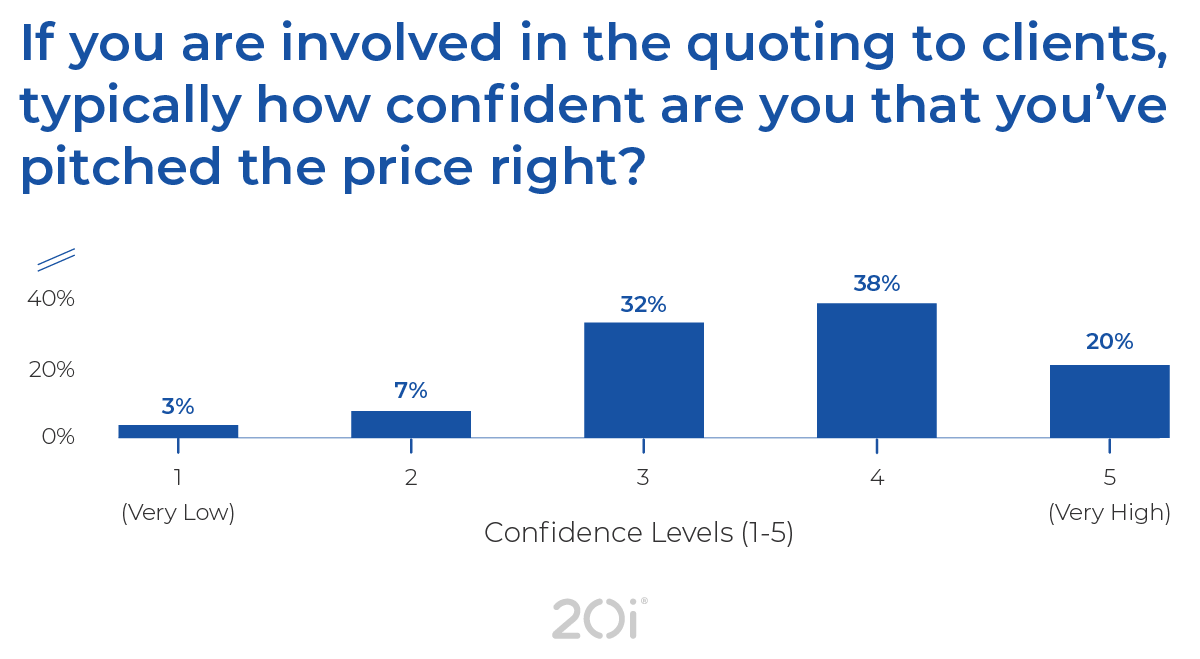
The less positive news is that nearly half of web designers don’t feel confident or very confident when pitching their fees. They could be missing out on a lot of money through imprecise pricing.
And given how rapidly the commercial landscape is changing at the moment, that’s not really surprising.
Lots of web designers are going freelance, so will be encountering the difficulty of knowing the worth of their work.
The impressive size of the industry also means more competition. So fledgling or struggling enterprises might be tempted to lowball themselves in order to win clients.
This is closely tied to our next question…
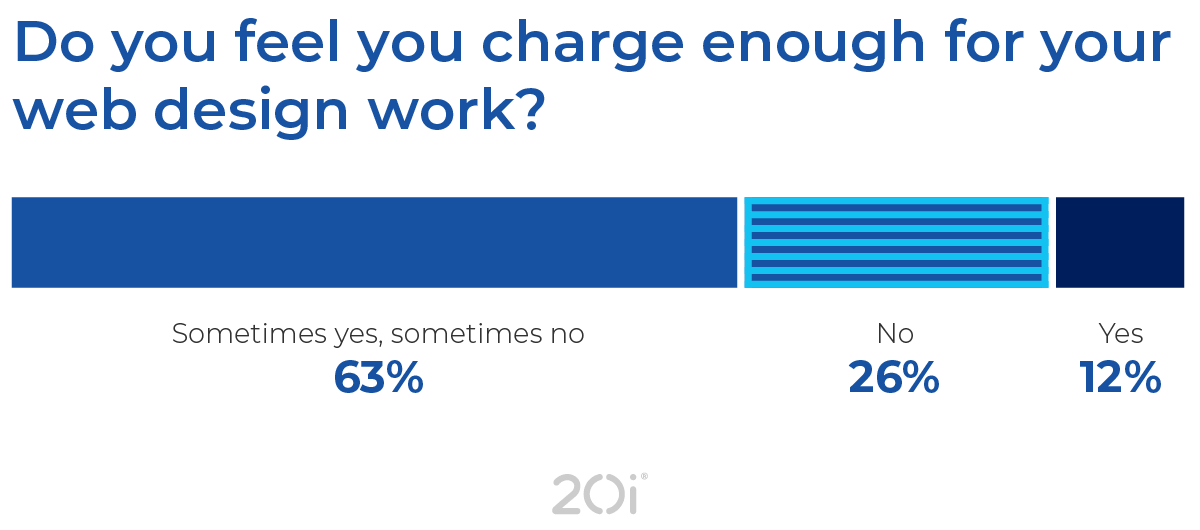
Accordingly, we then asked whether “clients often underestimate the cost of web design”. An impressive stat of 87% of web designers either agreed or strongly agreed with that statement .
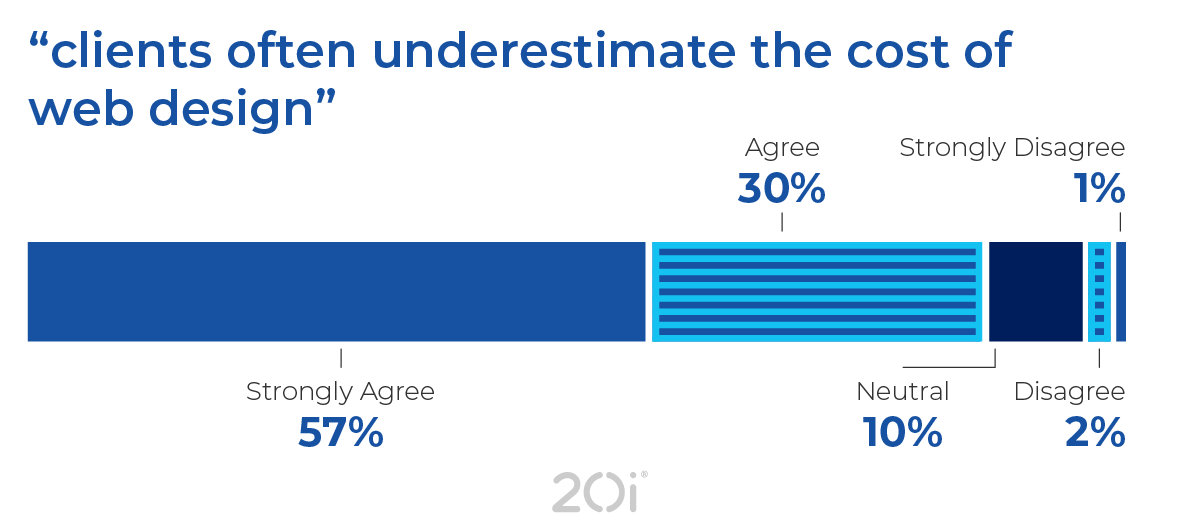
This is a buyer’s market, in which the vast majority of professionals aren’t fulfilling their earning potential.
Though the popularity of web design careers is great for the industry, the significant competition very much puts the client in the driving seat.
Section 3: Productivity and skills
Whatever the industry, recent events have had an unprecedented impact on the way we work. A huge portion of the population have experienced home working for the first time.
Here we look closer at how web designers feel about remote operating policies and the skills needed to succeed in today’s arena.
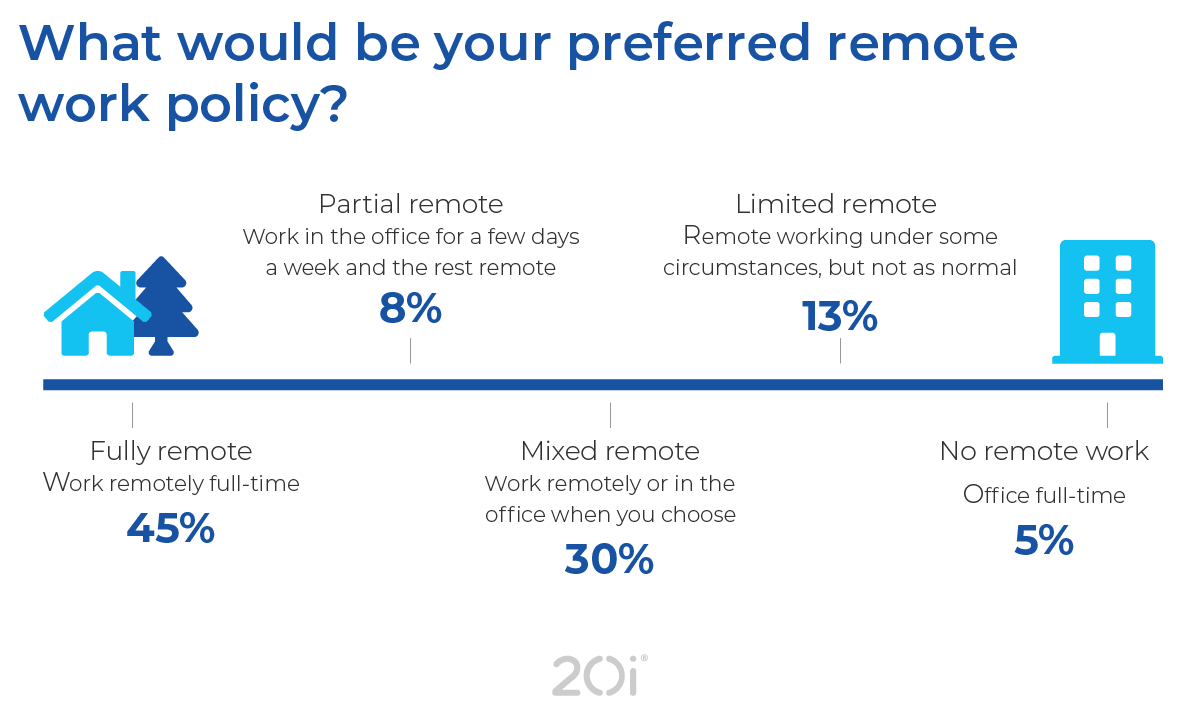
Only 5% would choose to only work from the office. This stat demonstrates the fundamental shift wrought by the pandemic in the way people operate. Individuals now expect control over where they should work.
Web designers’ most important skills
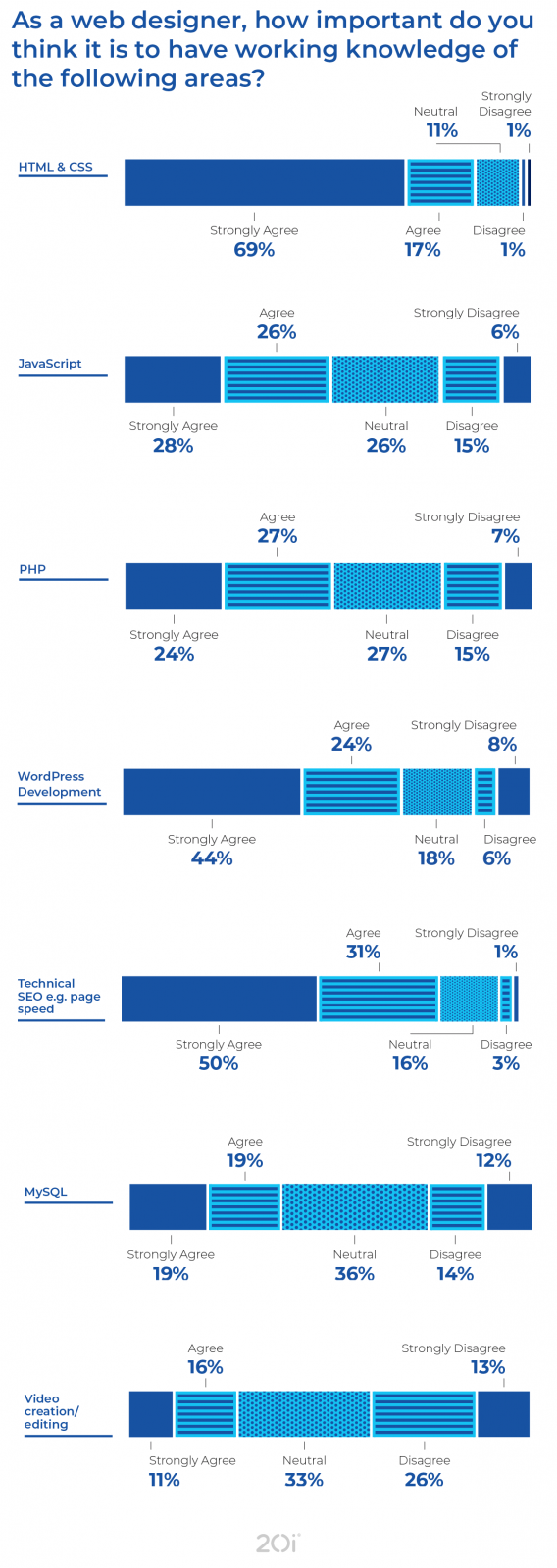
It is becoming increasingly rare to meet web designers without a working knowledge of HTML/CSS, illustrated by the 86% of respondents who agreed that this is an important area. Around half also believe JavaScript and PHP skills to be valuable.
According to our respondents (80.5%), the second most-crucial skill for web designers is a working knowledge of technical SEO .
As more organisations come to understand the necessity of a solid technical SEO base for SERP ranking and driving traffic, it appears that web designers are delivering these functions.
WordPress’ dominance as the increasingly-de-facto platform for building websites – currently used by 65.2% of websites with a CMS and 43% of all websites – is apparent from our stats. 67% agree or strongly agree that WordPress development skills are essential .
More on WordPress later.
Section 4: Your work
Now to the nitty-gritty of the type of work our respondents take on and how much they typically charge for it.
Aside from the purely pragmatic, we wanted to learn what aspects of web design they actually enjoy the most – the spark that keeps this industry so vibrant and dynamic – and how they find clients.
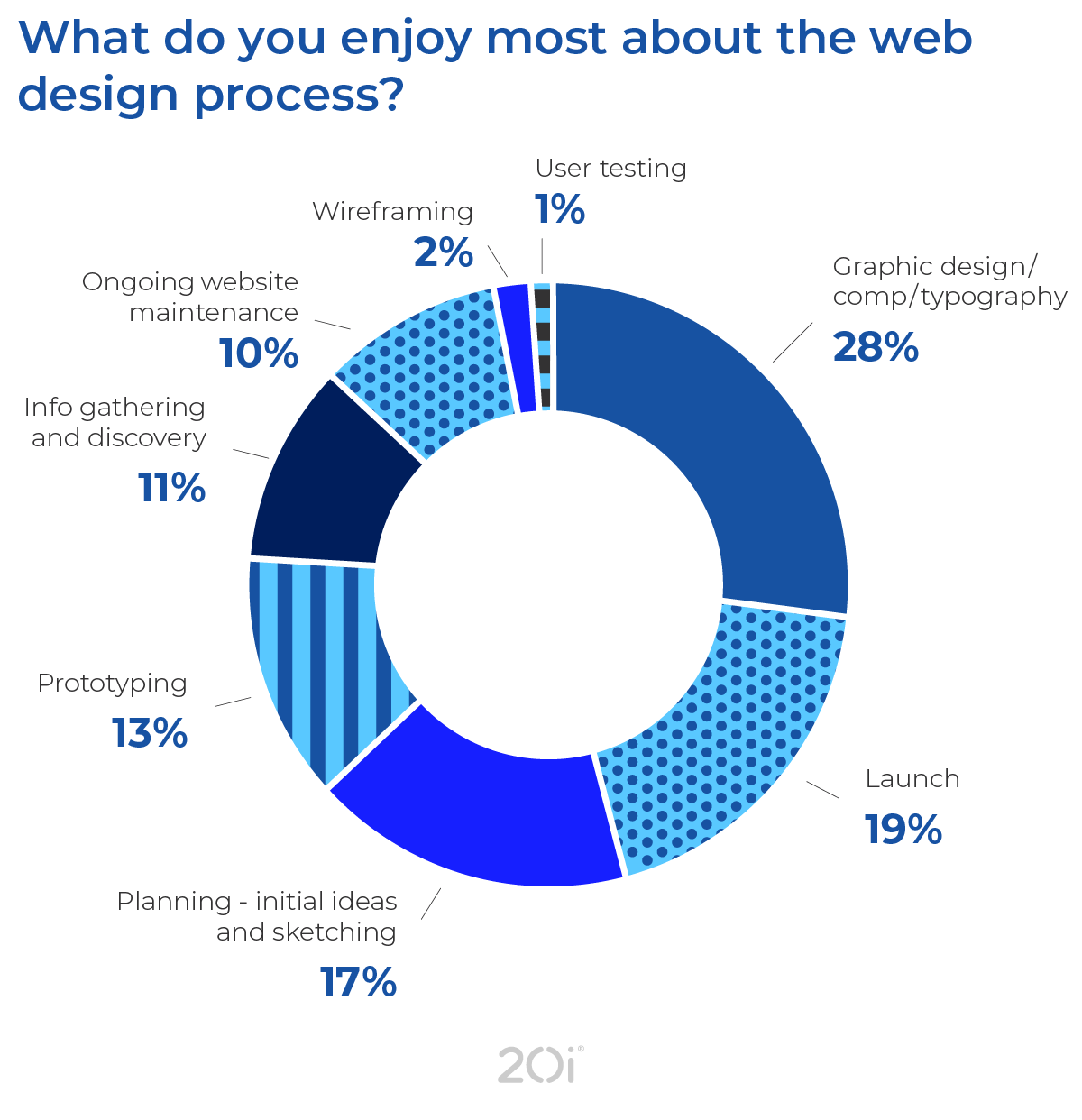
No real shocker in the stats here… the preferred part of the web design process is, well, the designing part. 28% of respondents put it at the top of their list, favouring the stage when ideas start pulling together and coming to life.
The next most-enjoyed parts of the process were its beginning and end – launch (19%) and planning (17%).
We can see that our respondents are drawn to the exciting moments. It’s when all the initial project ideas are bubbling around, waiting to be shaped and sketched into early concepts.
Then, the relief on completion. It’s sent out into the world, and they can sit back, satisfied with a job well done.
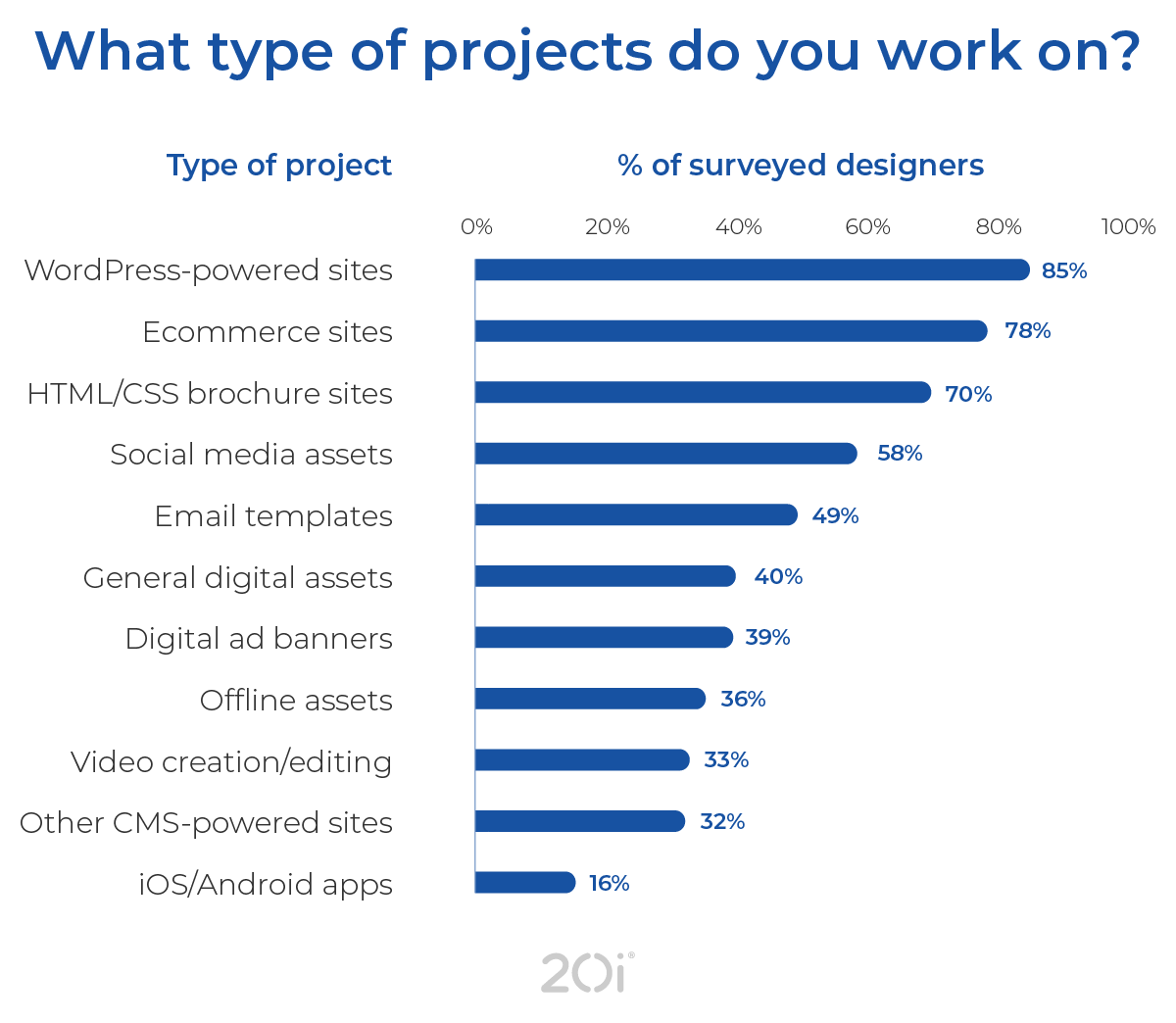
Web designers clearly need to be multi-disciplinary. 60% of respondents work on at least 5 different types of projects as part of their role .
The most common jobs are now WordPress-powered sites , even outranking the good old fashioned HTML brochure site, backing up how most respondents deemed WordPress development skills important.Digging deeper, we also asked whether “WordPress is my preferred platform for building websites”. We found that over two thirds of web designers agree or strongly agree WordPress is their preferred platform .
WordPress
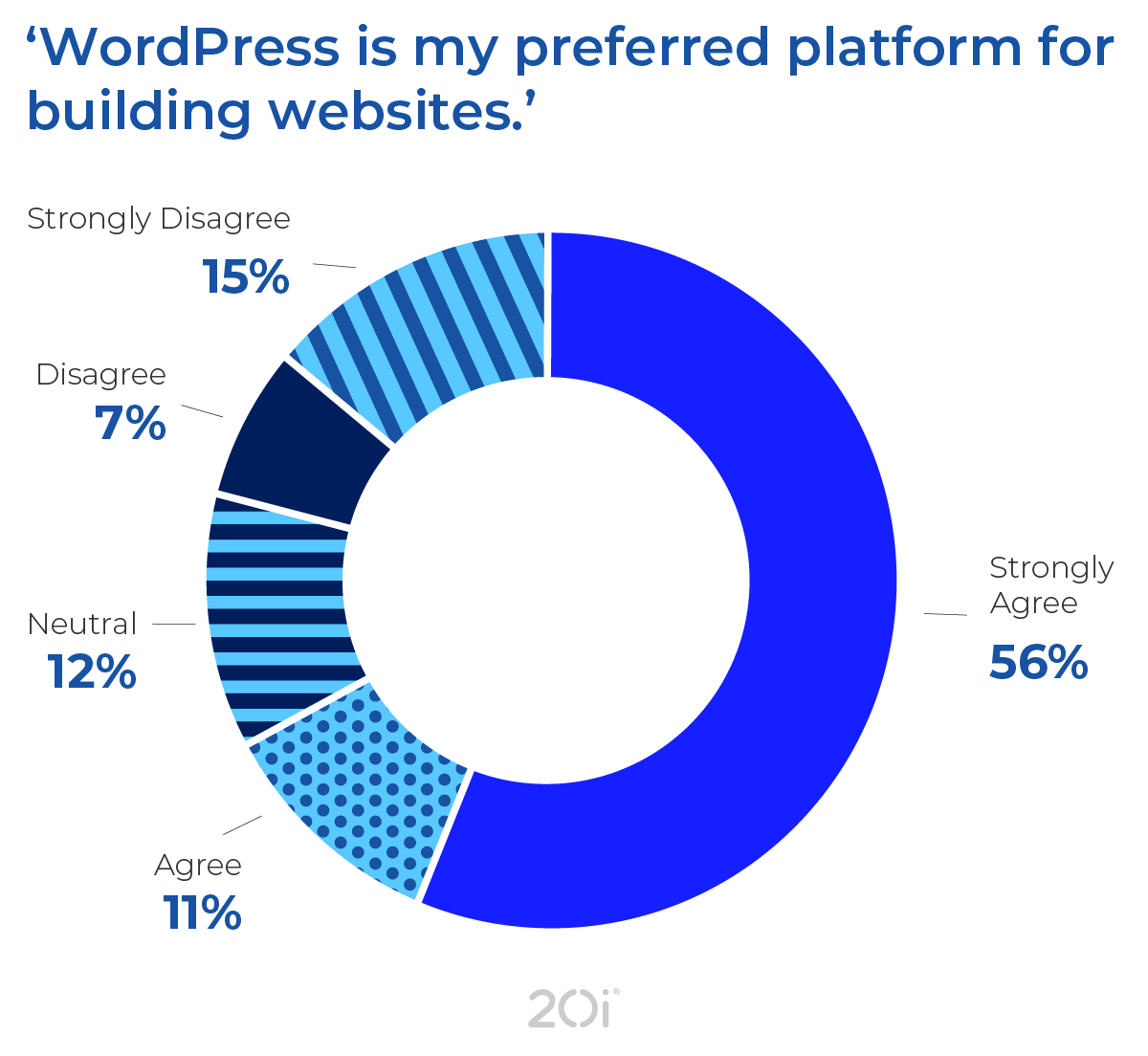
With WordPress claiming a 43% market share of the technology behind websites, it shouldn’t come as too much of a surprise that most designers are using it.
But just because you have to work on something, it doesn’t mean you like it. Luckily, for most of our respondents, they do.
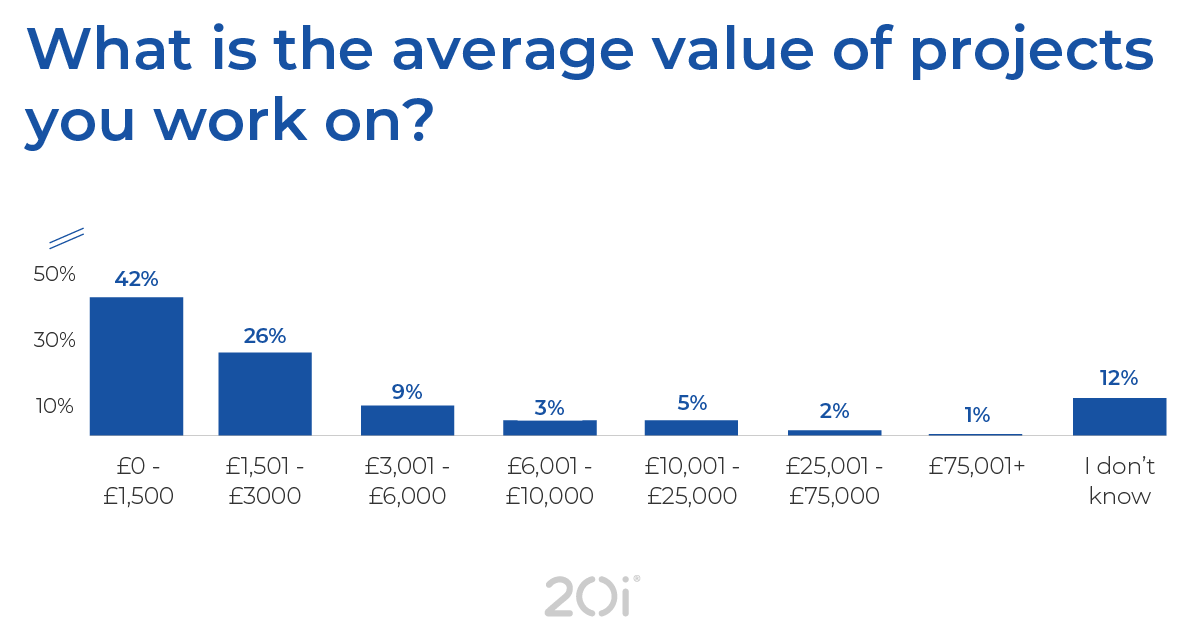
In an industry with a strong freelance population, and considering the challenges facing the wider economy, it’s encouraging that 20% of projects are being billed at over £3,000. There are still plenty of meaty contracts available out there.
The majority (68%) of are coming in at £3,000 or less. This tallyes with our stat that most gigs take less than a month to complete and few are of more than 3 months’ duration (see below).
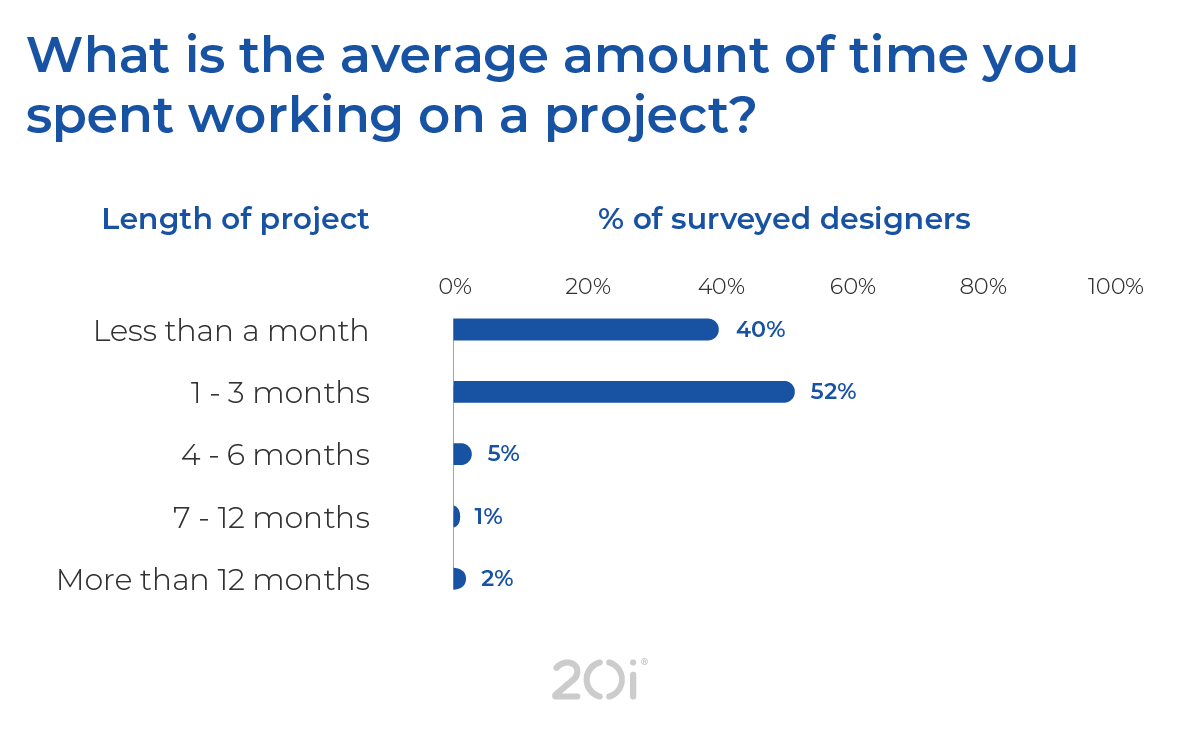
Web design undertakings tend to be short-term, with 40% taking no longer than a month and 92% taking less than three months to complete. Coupled with the project value data however, short-term doesn’t necessarily mean cheap.
Revenue and new work
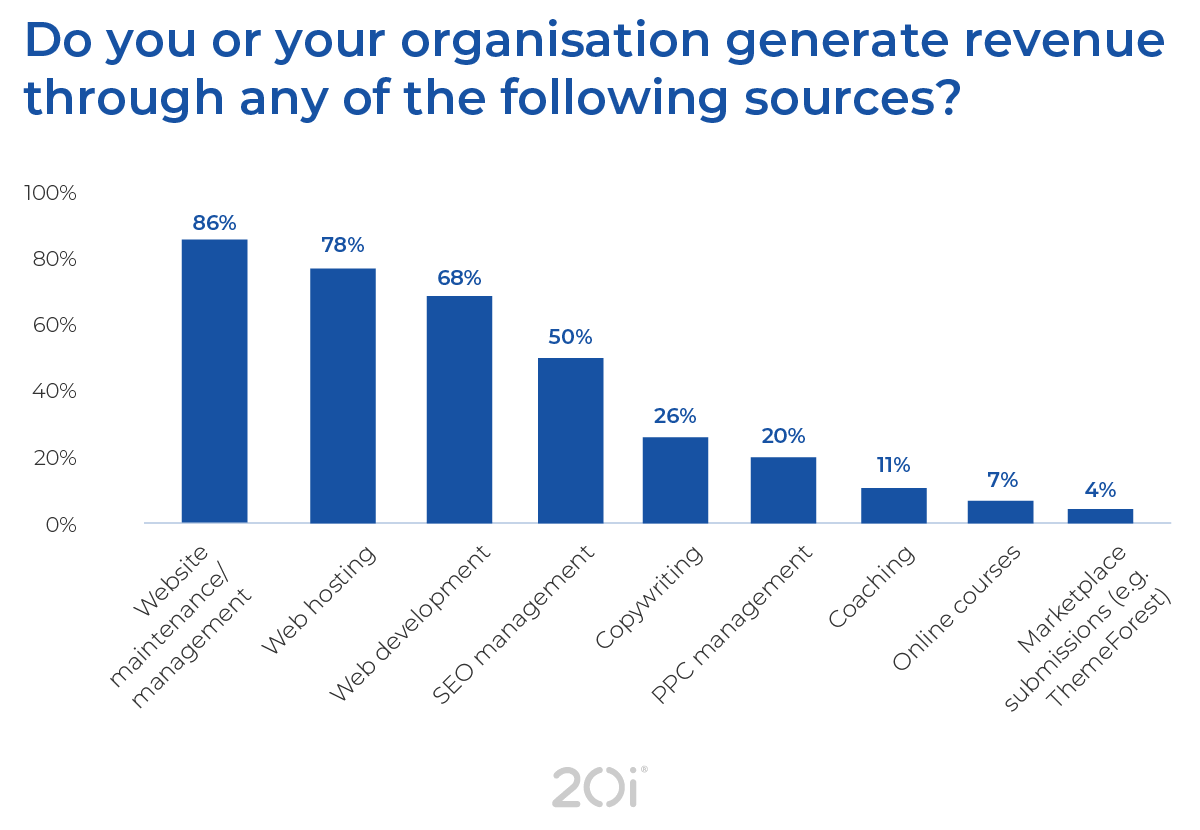
Ongoing website maintenance and hosting are prudent offerings, ensuring a reliable stream of recurring revenue. So it’s great to see the bulk of respondents already providing these.
It is useful though to bear in mind that, as this survey was conducted by a web host and reseller hosting company, the web hosting figures may be somewhat skewed.
Half of respondents’ organisations offer some ongoing SEO management services. It corresponds with the stat that 80.5% stated technical SEO as an important skill.
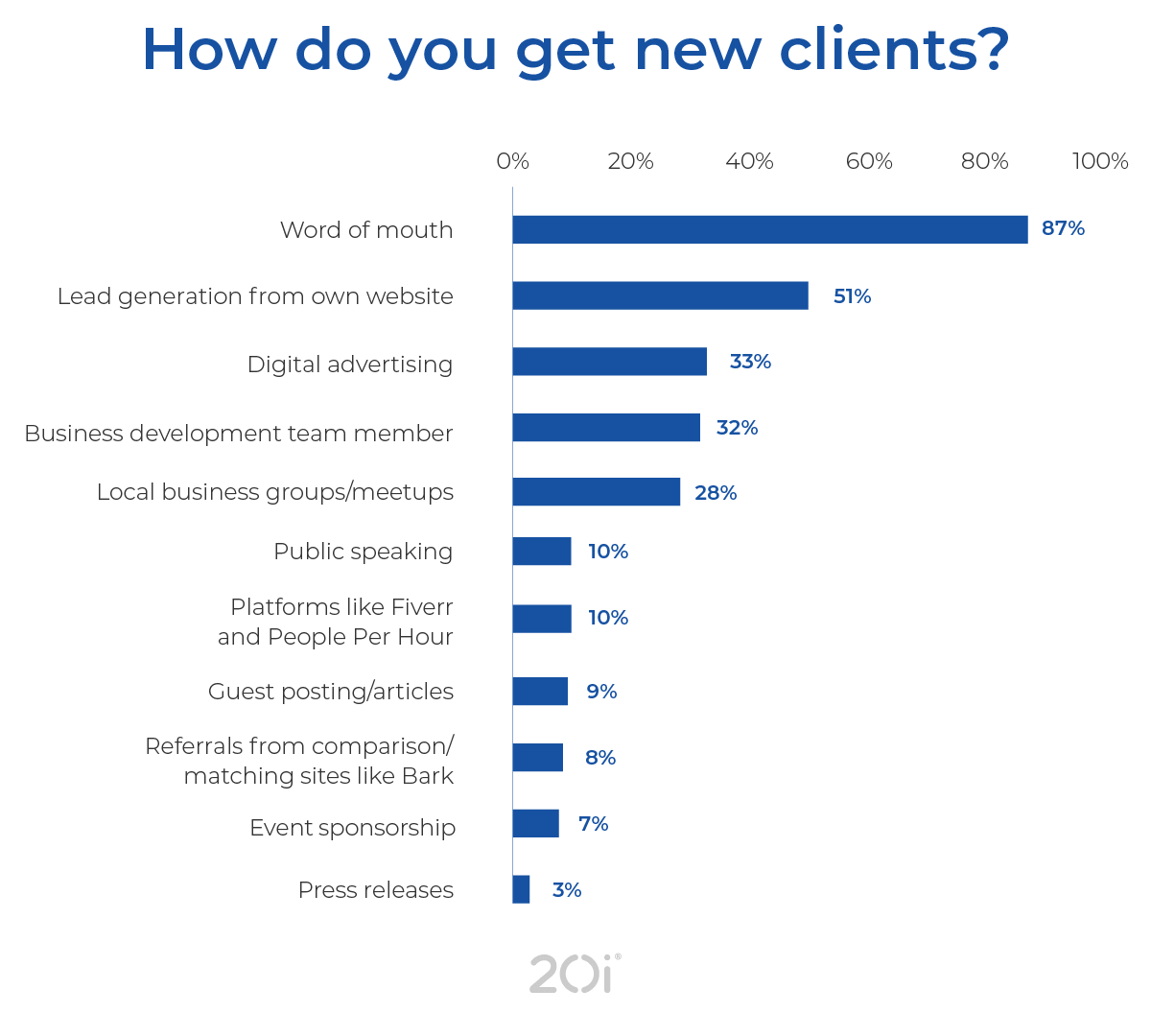
With a huge 87% of respondents gaining new business via word-of-mouth referrals , it’s apparent that superb results and client service are the key to commercial success.
On the other hand, whilst it’s good that the sector’s professionals are providing positive experiences, such a heavy reliance on passive business development is concerning.
It’s important to diversify your organisation’s marketing streams beyond just referrals. So that, should leads dry up, you have the tools to gain more.
Yet surprisingly, only half of our respondents have their own website to generate new leads , showcase services and target relevant local searches. It’s fair to say that this would limit opportunities and potentially hamper any future-proofing efforts.
Section 5: Trends
Lastly, we gauged the atmosphere, looking into levels of optimism around work availability and security, how enthusiastic web designers are feeling, and what the future might hold.
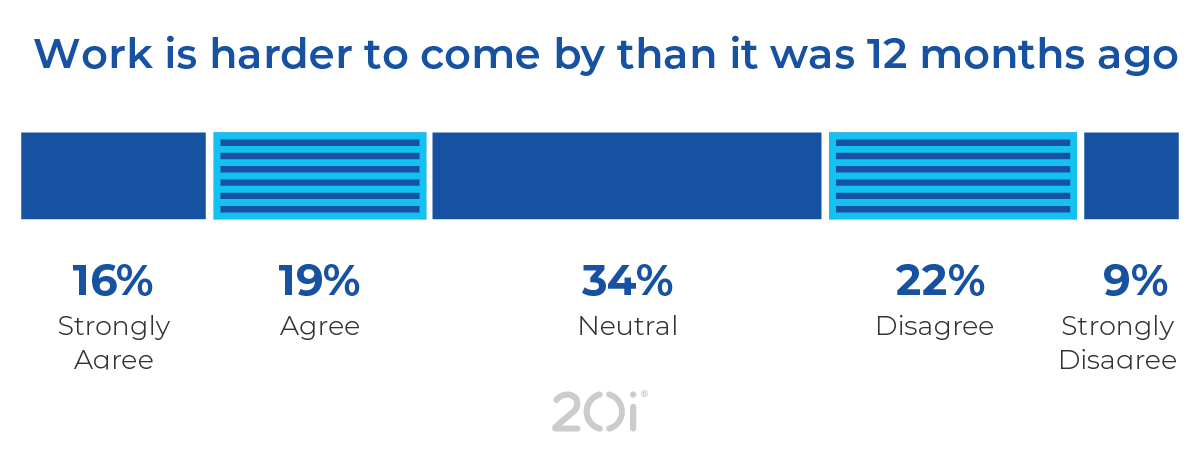
65% of web designers are not finding work harder to come by compared to this time last year, which is great news.
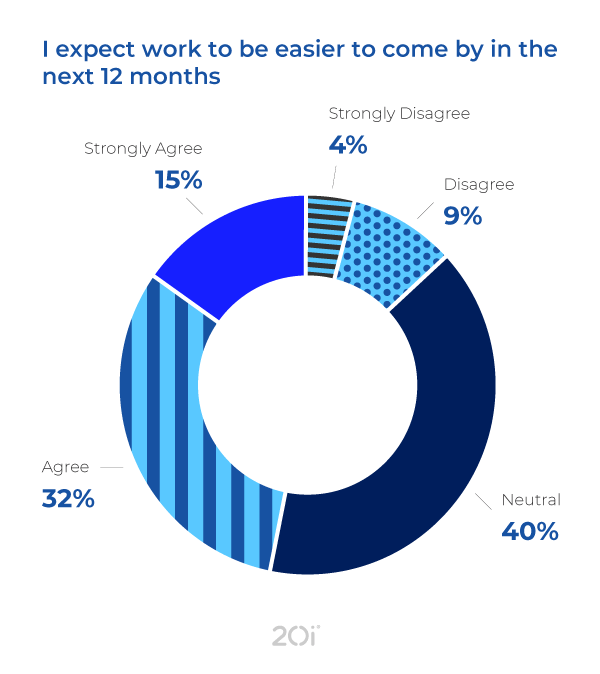
Our respondents are hopeful about the near future, with 47% of web designers expecting work to be easier to come by in the next 12 months .
This implies that digital experiences are predicted to continue dominating the marketplace. The shift to online retailing and events maintains its foothold, correlating with wider industry forecasts of steady financial growth.
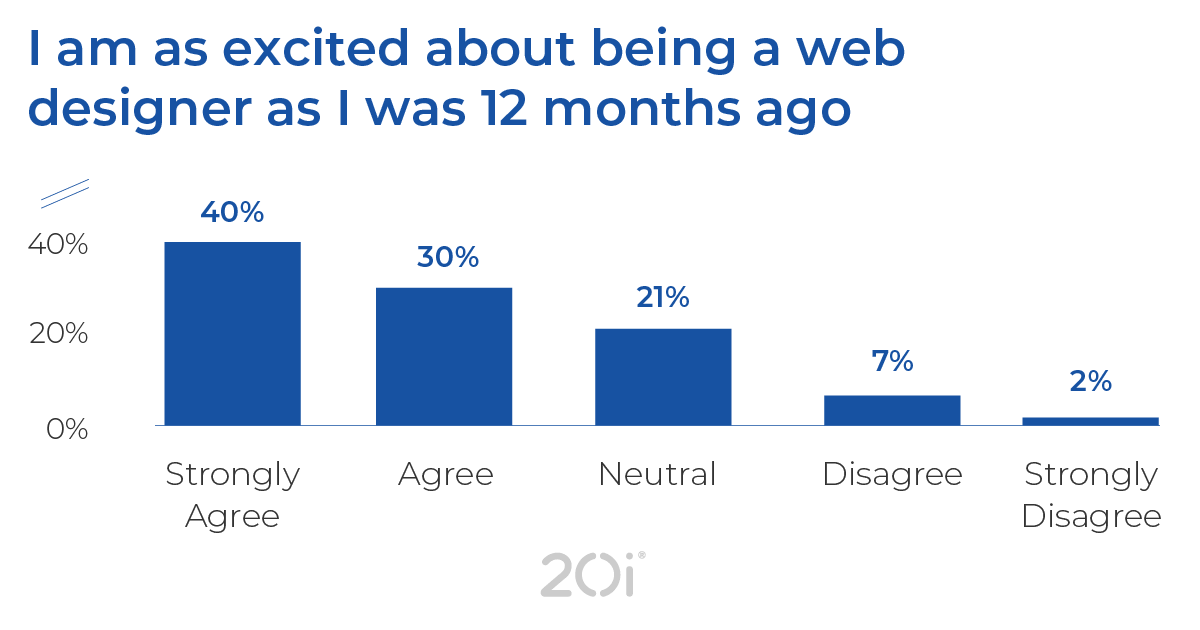
Despite the challenges presented by the pandemic and related economic downturn, it is reassuring to see that 70% of web designers are still as excited about their job as they were 12 months ago .
This shows that the sector’s professionals to be a resilient bunch. Aside from that, it also demonstrates how, for many, web design is as much a passion as it is a vocation. A source of satisfaction and enjoyment as well as income.
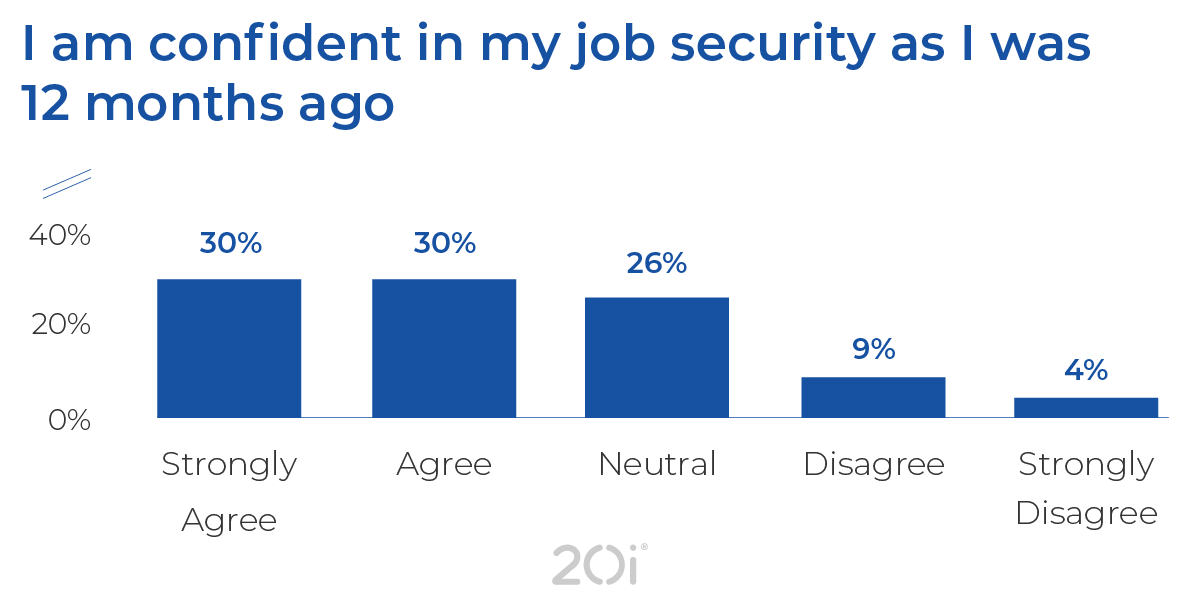
In another piece of good news, 60% are as confident in their job security as they were 12 months ago . Considering the vast swathes of workers who have lost their livelihoods post-COVID, it is encouraging to see web designers regaining their (professional) peace of mind.
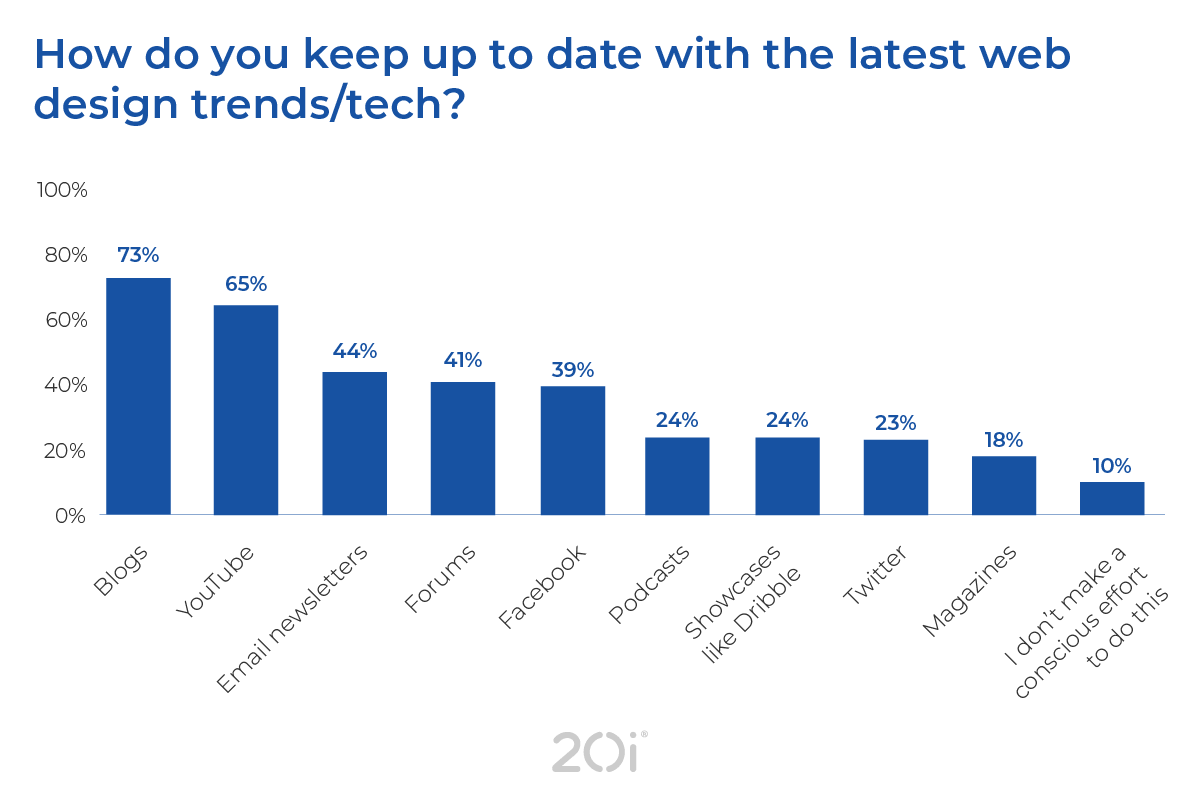
And finally, we asked how web designers stay up to date with the latest trends, advances and technology.
With the extensive traffic drawn in by popular web design blogs, it’s no surprise to see these are the source of most respondents’ industry news, followed by YouTube at 65%.
However, the responses also tell us that one in ten web designers make no conscious effort to stay up to date with industry developments.
This means a substantial portion of the sector’s workforce risks of falling behind their colleagues. In a rapidly advancing field with rising competition, now is the time to be swotting up!
Web designer stats: final thoughts
Our Web Designer Survey set out to learn what working life is like for the sector, how designers on the ground have been affected by the upheavals of the past couple of years and how they feel about the future.
The survey has uncovered conspicuous trends in professional sentiment, suggesting resilience and shifting priorities.
First of all, what really shows through the results is that web design continues to be a leading career choice, and that – despite the wider economy’s struggles – the industry remains buoyant.
The large demand can be seen in the hours responders are putting in, with most working full-time and 15% even dedicating more than 49 hours a week.
And though the bulk of gigs are short-term and charged at £3,000 or less, there are a promising number of higher-value projects available.
High competition
While these reports are encouraging, we have also unearthed tricky aspects to the popularity of web design as a vocation.
The field appears to be experiencing intense market competition and saturation, with many not fulfilling their earning potential and reported incomes falling below national averages.
Those employed agency-side tend to make the highest wages, but for a variety of reasons, most respondents believe they aren’t charging enough for their efforts.
This could explain the survey’s discovery that nurturing and promoting one’s skills is now a major priority for web designers.
90% make a conscious effort to stay up to date with industry news and developments, and a huge 43% are producing their own content, largely through blogging.
Though the survey results were inconclusive as to whether this leads to better earnings, it’s obvious that workers feel the need to maintain a winning edge.
The abundant market competition highlights our finding that professional standards and expertise are particularly stringent in the sector.
A multidisciplinary career
We can see that web designers must be multi-skilled and multidisciplinary, with most organisations providing web maintenance, hosting and development, as well as SEO.
Most respondents balance at least 5 different types of projects as part of their job, the most common of which are WordPress-related. The majority agree that knowledge of HTML/CSS is necessary for success.
A positive outlook for web designers
Despite these challenges, the survey also revealed that 87% of new business is derived from word-of-mouth referrals. This stat shows that the work is completed well and with excellent service.
Moreover, it’s easy to see widespread optimism and enthusiasm among web designers. 70% are still as excited about their career as they were 12 months ago. They are feeling confident in their job security and that work will become easier to acquire soon.
In fact, the survey shows that web designers have greater expectations, especially when it comes to freedom over ways of working.
Most respondents are in permanent roles, and most prefer to operate remotely, but the freelance population now stands at a significant 41%. This indicates a shift toward more personal choice in professional life.
In conclusion, the survey outlines a thriving industry in real demand, but also in which competition is fierce. The standards and requirements are likewise high, and effort is being exerted on skills development and self-promotion. But at the end of the day, web designers are feeling empowered to have a say over how they work and are hopeful about their careers.
Methodology and data
The respondents to this survey are self-described web designers with whom we invited to take part in via a number of different channels including email and social media.
- Data was captured using a Google Forms survey with 33 questions
- Responses were gathered between April and August 2021
- The data set is populated with our Reseller Hosting customers which naturally skews towards hosting their own clients.
Download the report
Download your own copy of our Web Designer Survey. Note: This isn’t taking you to a lead generation form or asking for your email address, it’s just a good old fashioned link to a lovingly-designed PDF.


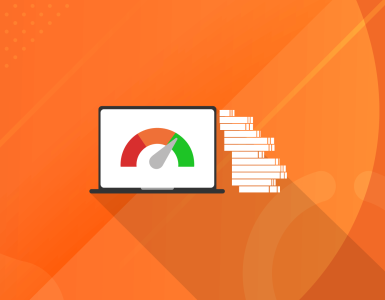










Is this form working?
It seems to be! 🙂
A very useful survey for those of us working alone. Would be great if you could do it each year. This service made me feel that there is a surely some kind of niche for support for such a large pool of freelancers, helping them, and agencies, to know their industry better and to support each other. As I don’t see a successful thriving service like this online for the UK, perhaps 20i are in the best position to do this? If anyone does know of such a service/portal, please tell us.
Hi Alan, a UK based community site is a great idea. https://millo.co/ is a good site and there are quite a lot of Slack based communities dotted around, although the majority are US focused.
This is a fantastic blog, could I possibly re-post it?
Hi Chris, it’ll be great to read your take on the findings.
I have to ask, where are most of these web designers located? $30,000 / year is a really low average salary. At least, low from my point of view. I’m in North America, so $30,000 wouldn’t even pay for rent in my city. However, if someone was in India or Romania, $30,000 might be much more liveable. Still, the currency used here is Euro’s and in most Euro countries $30k seems low.
Web designers need to charge more!
Hi Kevin,
The majority of respondents were based in Europe (the largest pot being the UK) with some in the US. This is definitely an area we can dig even deeper in to the data with.
Cheers,
Matt
I think much about this survey is interesting and probably much of what would be expected.
One point I think is open to interpretation is the amount of hours = web designers are in high demand. Alternatively and in my own experience and I know of others too, that this could mean, just difficult clients, trying to resolve a problem or getting stuck on a program, it doesn’t mean high demand necessarily.
Thank you.
Hi Andrew – yes, I agree that the point about the number of hours worked is open to interpretation – as I’m sure other stats are too. We appreciate your input.